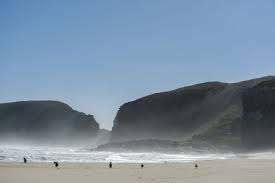History of Plettenberg Bay
- Province: Western Cape
- Garden Route
- Coordinates:34°03′S 23°22′E
- Area:39.7 km2
- Municipality: Bitou
Bahia das Alagoas and shipwrecks
Portuguese explorers charted this area in the 15th and 16th centuries. when Bartholomew Dias found the sea route between Europe and Asia. He called, what is now Plettenberg Bay “Bahia das Alagoas”, meaning “Bay of the Lagoons.” He named Robberg “Cabo Talhado”, meaning “Sharp Cape. Manuel da Perestrello arrived 90 years later and called it Bahia Formosa” meaning “Beautiful Bay”
The first Europeans in the area were shipwrecked sailors from the São Gonçalo which sank, on her way back from India. 100 sailors survived and in Piesang Valley, they managed to build two boats using wood from the forests with which they eventually managed to sail out. They were picked up at sea by the Sao Ignatius Loyola which was on its way back to Portugal. Sadly this ship did not reach Portugal because it wrecked in the Bay of Lisbon with much loss of life. They left a stone monument to the shipwreck on which was inscribed in Portuguese “Here was lost the ship São Gonçalo in the year 1630”.
The first Europeans to settle in the bay were stock farmers, hunters, and frontiersmen who traveled up from the Western Cape. The bay was given different names by Portuguese sailors such as Baia de la Goa, Angra das Alagoas ( for the marshy lagoons) Baia Sao Catharina, and Baia Formosa. The Dutch also gave it various names such as Content Bay, Keurbooms Bay, and Pisang River Bay.
A woodcutter’s post was established in 1787 when Johann Jacob Jerling, was commissioned by the Dutch East India Co. to build a timber storehouse. The first load was exported by De Meermin in August 1788 This building has been partially restored, it still stands today and has been made a National Monument.
Forestry
There were great forests in the area consisting of stinkwood, yellow wood, sneeze wood, ironwood, and other massive trees Woodsmen would fell them manually and cut them into planks using hand saws.
The timber was transported by sea with the logs being loaded aboard the ships by oxen. Logs were also transported to Cape Town by wagon.
Whaling
The Dutch East India Company started commercial whaling in South Africa at the start of the 18th Century and opened it up to investors. An English merchant, John Murray started controlling the whaling industry in the area. Plettenberg Bay was one of six places identified nationally for whaling and the industry flourished. In 1910 Captain Sinclair set up the whaling station on Beacon Island in order to harvest the placid Southern Right whales but this operation ceased in 1916. These whales would yield more oil and whalebone which was an essential component of Victorian corsets. In the nineteenth century, a southern right would net around three times as much as a humpback whale. This led to a decline in the southern right population by the time whaling was halted.
Devastating fires
Because of the timber trade, Thomas Bain was commissioned to build Prince Alfred Pass and a 90 km road between Tsitsikamma and Humansdorp. The building was made easier by The Great Fire of 1869 which has gone down in the records as possibly the most devastating and terrifying event of the times. However, history was repeated in 2017 In what is now called the “Great Fire”, perfect weather conditions came together creating a huge fire that swept through both Knysna and Plettenberg Bay in June of that year.
During the Apartheid era, Plettenberg Bay was predominantly a white area with informal settlements of Xhosa migrants around the edges of New Horizons and in the area of KwaNokuthula which became a town. KwaNokuthula is home to a varied number of ethnic groups and it is a Xhosa word meaning “place of peace”.
Joachim Ammema Baron van Plettenberg.
Van Plettenberg was born in Leeuwarden in the Netherlands. He studied law at Utrecht and joined the service of the Dutch East India Company, which sent him to Batavia in 1764. In 1766 he was sent as Independent Fiscalto the Cape and he was promoted to Secunde and then to Governor in 1774. There was war with the British in the time he was Governor and reinforcements were sent from France. Van Plettenberg took great interest in exploring the colony but there was some discontent about his administration and an inquiry was held in Holland. He retired in 1785 and lived the rest of his days in Zwolle. He died in 1793.
The license plate prefix for Plettenberg Bay is CX and the postcode is 6600
WEATHER IN PLETTENBERG BAY TODAY
all listings in Plettenberg Bay
Things to do and see in Plettenberg Bay
- Fountainshack trail
- Bloukrans pass
- The ship’s pot and anchor from the Jane can be seen on a farm near Keurbooms River. The ship’s bell engraved with the name was used by the church in Pisang River
- Plett ARTS Festival held in June
- The Dutch Reformed Church at Wittedrif was built in 1843. There is a cannon from an unknown wreck is on the property
- Some large iron cauldrons from the whaling industry can be seen on Beacon Island.
- Artifacts from the shipwrecked crew of the Sao Goncalo are kept in the municipal offices
- The postal code for Plettenberg Bay is 6600 and the car registration prefix is CX
Useful Numbers in Plettenberg Bay
- Municipality – 044 501 3174/5
- Police: 044 501 1900
- Traffic department:044 501 3240 / 3251
- Home affairs: 081 070 0020
- Fire: 0445013230 / 044 533 5000
- Water:044 501 3122
- Electricity:044 501 3000
- Ambulance: 10177
- Post office;044 533 1260
- Library:044 501 3128
- NSRI: 082 990 5975
- Closest hospital; Mediclinic -044 501 5100
- Community Health Centre-044 501 3700
- Pharmacy; Robberg Pharmacy-044 501 4630
- SPCA: PAWS Plett Animal Welfare Service-083 287
- Local Newspaper Knysna Plett Herald 044 382 1185
- Municipal facilities
- Piesang Community Town Hall: 044 501 3360 /078 144 0029
- New Horizon Community Hall:044 501 3000/0788201724
- Bicycle Shelter Community Hall:044 501 3000/078 646 2030
- Green valley Community Hall:044 501 3452
- Kranshoek community hall:044 501 3314/078 164 6732
- Kranshoek sports field: 044 501 3314
- Plettenberg Bay rugby field:044 501 3328/081 436 6213
- New Horizon Sport field:044 501 3000/084 405 2005
- Tourism Plettenberg Bay 044 533 0965
- Schools: Plettenberg Bay Primary School-044 533 2126
Greenwood Bay College-044 533 2549
Formosa Primary School-044 533 1621
Bahia Formosa Primary School-044 533 1498
Plett Pre Primary School-044 533 2542
Plettenbergbaai Secondary School-044 533 0472
GBC Primary and High School-044 533 2549
Raphaeli Waldorf School-044 533 6157
Plettenberg Bay Christian School-044 533 2394
Phakamisani Primary School-044 533 3029
Murray High School-044 533 3193
Die Sterreweg-044 533 2639
Wittedrift High School-044 535 9731
Kwanokuthula Primary-044 533 1626
Kranshoek Primary School- 044 533 9357
Harkerville Ek Primary School-044 535 7703
Other towns and suburbs in the Bitou district include; Harkerville: Keurbooms River; Keurboomstrand: Kranshoek; Kurland village; Natures Valley; and Wittedrift;



